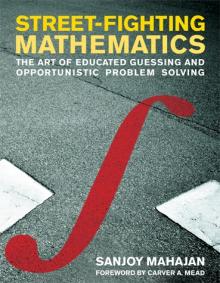Street-Fighting Mathematics: The Art of Educated Guessing and Opportunistic Problem Solving by Sanjoy Mahajan.
From the webpage:
In problem solving, as in street fighting, rules are for fools: do whatever works—don’t just stand there! Yet we often fear an unjustified leap even though it may land us on a correct result. Traditional mathematics teaching is largely about solving exactly stated problems exactly, yet life often hands us partly defined problems needing only moderately accurate solutions. This engaging book is an antidote to the rigor mortis brought on by too much mathematical rigor, teaching us how to guess answers without needing a proof or an exact calculation.
In Street-Fighting Mathematics, Sanjoy Mahajan builds, sharpens, and demonstrates tools for educated guessing and down-and-dirty, opportunistic problem solving across diverse fields of knowledge—from mathematics to management. Mahajan describes six tools: dimensional analysis, easy cases, lumping, picture proofs, successive approximation, and reasoning by analogy. Illustrating each tool with numerous examples, he carefully separates the tool—the general principle—from the particular application so that the reader can most easily grasp the tool itself to use on problems of particular interest. Street-Fighting Mathematics grew out of a short course taught by the author at MIT for students ranging from first-year undergraduates to graduate students ready for careers in physics, mathematics, management, electrical engineering, computer science, and biology. They benefited from an approach that avoided rigor and taught them how to use mathematics to solve real problems.
I have just started reading Street-Fighting Mathematics but I wonder if there is a parallel between mathematics and the semantics that everyone talks about capturing from information systems.
Consider this line:
Traditional mathematics teaching is largely about solving exactly stated problems exactly, yet life often hands us partly defined problems needing only moderately accurate solutions.
And re-cast it for semantics:
Traditional semantics (Peirce, FOL, SUMO, RDF) is largely about solving exactly stated problems exactly, yet life often hands us partly defined problems needing only moderately accurate solutions.
What if the semantics we capture and apply are sufficient for your use case? Complete with ROI for that use case.
Is that sufficient?
